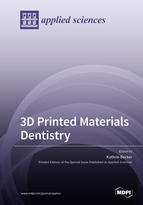3D Printed Materials Dentistry
A special issue of Applied Sciences (ISSN 2076-3417). This special issue belongs to the section "Materials Science and Engineering".
Deadline for manuscript submissions: closed (20 June 2022) | Viewed by 27906
Special Issue Editor
Interests: bone micro-morphometry; 3D imaging; dental radiology; orthodontic implants; skeletal anchorage
Special Issues, Collections and Topics in MDPI journals
Special Issue Information
Dear Colleagues,
This Special Issue of the journal Applied Sciences entitled 3D Printed Materials in Dentistry aims to present recent findings in the generation and utilization of novel, 3D printed, materials in orthodontics, oral and maxillofacial surgery, prosthodontics, and restorative dentistry. Authors willing to present their original, unpublished work or willing to provide a systematic review on the topic are invited to submit their manuscripts for consideration in the special issue. Eligible manuscripts will be subject to a peer-review process according to the guidelines of the journal.
Potential topics include but are not limited to:
- Sterilization and its impact on printed materials
- 3D manufacturing processes
- Digital workflow and sources of error
- Metals used in additive or subtractive procedures
- Metal printing / resin printing technologies
- Biomechanical properties of 3D printed materials
- Accuracy and precision of 3D printed materials
- Biocompatibility
- Survival and failure rates
- Individualized treatment approaches
- Patient reported outcomes
Dr. Kathrin Becker
Guest Editor
Manuscript Submission Information
Manuscripts should be submitted online at www.mdpi.com by registering and logging in to this website. Once you are registered, click here to go to the submission form. Manuscripts can be submitted until the deadline. All submissions that pass pre-check are peer-reviewed. Accepted papers will be published continuously in the journal (as soon as accepted) and will be listed together on the special issue website. Research articles, review articles as well as short communications are invited. For planned papers, a title and short abstract (about 100 words) can be sent to the Editorial Office for announcement on this website.
Submitted manuscripts should not have been published previously, nor be under consideration for publication elsewhere (except conference proceedings papers). All manuscripts are thoroughly refereed through a single-blind peer-review process. A guide for authors and other relevant information for submission of manuscripts is available on the Instructions for Authors page. Applied Sciences is an international peer-reviewed open access semimonthly journal published by MDPI.
Please visit the Instructions for Authors page before submitting a manuscript. The Article Processing Charge (APC) for publication in this open access journal is 2400 CHF (Swiss Francs). Submitted papers should be well formatted and use good English. Authors may use MDPI's English editing service prior to publication or during author revisions.
Keywords
- dental materials
- 3D printing
- additive procedures
- subtractive procedures
- metal printing
- resin printing






